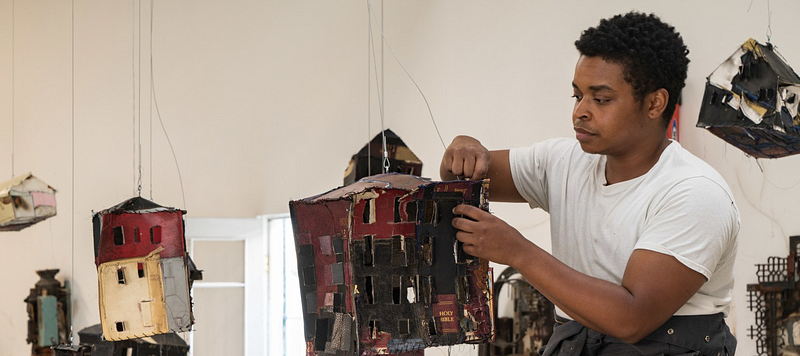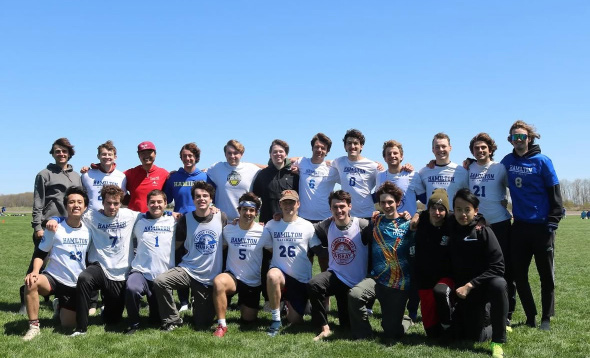
On Feb. 21, Hamilton welcomed Chiffon Thomas through the Art Department’s Visiting Artist Series. The talk took place in the Kirner Johnson Building’s Bradford Auditorium, and welcomed both students, faculty, and off-campus guests. Thomas spoke with the audience alongside a visual presentation, which included both video and photo elements, including one of Thomas’s stop-motion animations that he described as incredibly significant in shaping his artistic path.
Thomas, born and raised in Chicago, creates art covering a range of topics, including nostalgia, queerness, religion, race, and identity. Before attending the Skowhegan School of Painting and Sculpture and the Fountainhead Residency, Thomas was a public school teacher for three years in his hometown. Thomas also holds both a BFA from the Art Institute of Chicago and an MFA Masters from Yale University, earned in 2014 and 2020, respectively.
Thomas identifies as a trans queer person of color and these elements, and how they are perceived in society, are evident in his artwork, which can often portray sentiments of enclosure and understanding of the self, both of the present and past. He also recounts his large influences as Louise Bourgeois, Martin Puryear, Bell Hooks, and Octavia E. Butler.Similarly, he describes his religious upbringing as an important influence in his artwork. During an artist critique as a Yale student, Thomas received a comment pointing out that he appeared to have a clear interest in verticality, and was encouraged to look further into columns as an art form. Thomas described this note as incredibly “helpful” as it helped shape his artistic journey. Furthermore, throughout a three-week funded trip to Brescia, Italy, during his time at Yale, he completed daily trips to the Museo Della Città, exploring various column designs and constructions. This exposure to columns’ impact is evident in Thomas’s work, particularly in the later years of his time at Yale.
As Gregory Parizhsky ’26 said, “I felt that the intersection of salvaged and found materials and his understanding of his identity and roots allowed for unique sculptures that broke through traditional barriers. The use of color in the knitting techniques and the colonial-style columns felt like both an exploration of body and history.”
Part of his inspiration also comes from the circular windows of the Chicago building he grew up in. These windows reminded him of optical elements and different modes of seeing, components he saw reflected in the architecture of Rome’s Pantheon and Florence’s Duomo; this round shape, reminiscent of an eye, is reflected in Thomas’s works.
Thomas has had a range of recent exhibitions across the country, including Antithesis at the Michael Kohn Gallery in Los Angeles in 2021, Staircase to the Rose Window at P.P.O.W. in New York City in 2022, and his first solo exhibition titled Chiffon Thomas: The Cavernous at the Aldrich Contemporary Art museum in Ridgefield, Connecticut, among others. Thomas’s work is permanently included at several museum collections, including at the San Francisco Museum of Modern Art in California, the Studio Museum in Harlem, New York, the Institute of Contemporary Art in Miami, and the X Museum in Beijing, China, and others.
Throughout his presentation, Thomas explored the evolution of his work, which early on included a focus on embroidery, specifically depictions of his family and youth using textile, transforming images into sketches and then into stitched scenes. These works included realistic portrayals of family members, though also incorporated the representation of more metaphorical elements, like the notion of fractality, intended to highlight the missing elements within the relationships he portrays.
However, over time, Thomas’s work has evolved into a focus on sculpture, which he describes as more tactile, an integral and necessary transformation within his artistic journey. This transition was further acknowledged during the last few minutes of the event by an audience member’s question, which highlighted the mirroring of his gender and artistic transitions.
“He was so real… to watch his art trajectory was a really cool thing,” Lily Rizzoli ’24 told The Spectator. “The room was packed and the students seemed to love it, and someone even said, ‘this is the most applause any of the visiting artists have gotten’… he was so humble, he was so passionate and he was very open with his struggles and it was really cool.”














